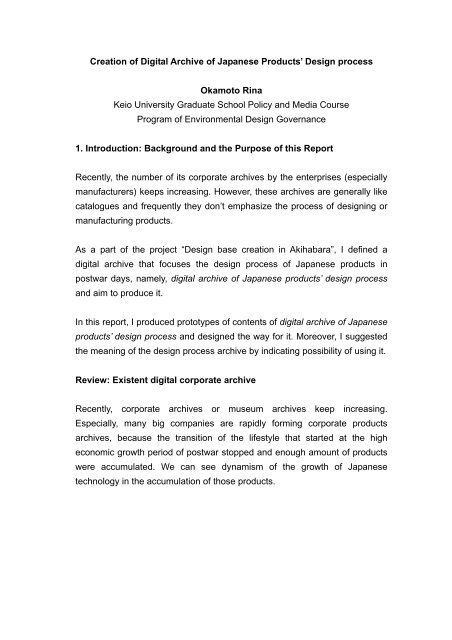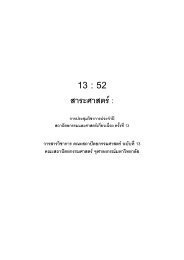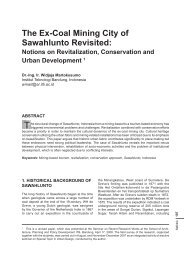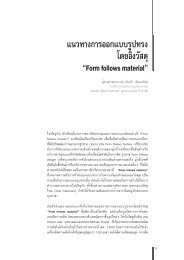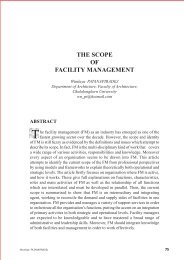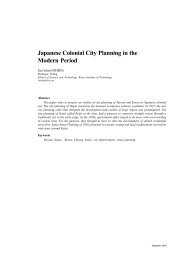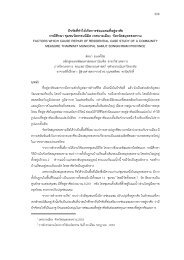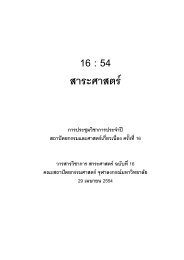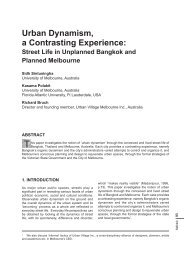Creation of Digital Archive of Japanese Products' Design process ...
Creation of Digital Archive of Japanese Products' Design process ...
Creation of Digital Archive of Japanese Products' Design process ...
You also want an ePaper? Increase the reach of your titles
YUMPU automatically turns print PDFs into web optimized ePapers that Google loves.
<strong>Creation</strong> <strong>of</strong> <strong>Digital</strong> <strong>Archive</strong> <strong>of</strong> <strong>Japanese</strong> Products’ <strong>Design</strong> <strong>process</strong>Okamoto RinaKeio University Graduate School Policy and Media CourseProgram <strong>of</strong> Environmental <strong>Design</strong> Governance1. Introduction: Background and the Purpose <strong>of</strong> this ReportRecently, the number <strong>of</strong> its corporate archives by the enterprises (especiallymanufacturers) keeps increasing. However, these archives are generally likecatalogues and frequently they don’t emphasize the <strong>process</strong> <strong>of</strong> designing ormanufacturing products.As a part <strong>of</strong> the project “<strong>Design</strong> base creation in Akihabara”, I defined adigital archive that focuses the design <strong>process</strong> <strong>of</strong> <strong>Japanese</strong> products inpostwar days, namely, digital archive <strong>of</strong> <strong>Japanese</strong> products’ design <strong>process</strong>and aim to produce it.In this report, I produced prototypes <strong>of</strong> contents <strong>of</strong> digital archive <strong>of</strong> <strong>Japanese</strong>products’ design <strong>process</strong> and designed the way for it. Moreover, I suggestedthe meaning <strong>of</strong> the design <strong>process</strong> archive by indicating possibility <strong>of</strong> using it.Review: Existent digital corporate archiveRecently, corporate archives or museum archives keep increasing.Especially, many big companies are rapidly forming corporate productsarchives, because the transition <strong>of</strong> the lifestyle that started at the higheconomic growth period <strong>of</strong> postwar stopped and enough amount <strong>of</strong> productswere accumulated. We can see dynamism <strong>of</strong> the growth <strong>of</strong> <strong>Japanese</strong>technology in the accumulation <strong>of</strong> those products.
・Case1: CANON CAMERA MUSEUMFig1, 2Public contents in the Internet. Presentation <strong>of</strong> all models <strong>of</strong>CANON's cameras and corporate historyCANON CAMERA MUSEUM・Case2: Matsushita Electric Industrial’s company history digital archiveIn-house contents in the Intranet. Presentation <strong>of</strong> materials about corporatehistory and founder・Case3: Nippon StyleFig3.4Nippon StylePublic contents in the Internet. Presentation <strong>of</strong> <strong>Japanese</strong> productssymbolizing change <strong>of</strong> <strong>Japanese</strong> lifestyle postwar.・Case4: Dai Nippon Printing “SHASI no MORI”Public database <strong>of</strong> corporate history published by DNPOriginally, archive is to preserve materials and arrange them. But we paidattention not only to materials as result <strong>of</strong> action but also to the <strong>process</strong> <strong>of</strong>production, because we noticed that the wisdom helping breakthrough andtacit information for manufacturing products rises to the surface by dividing
and demonstrating the designing <strong>process</strong> in detail. It might be pr<strong>of</strong>itable formanufacturing products (not only <strong>of</strong> today but also <strong>of</strong> the future) to formalizethis tacit knowledge that has been unconsciously shared. The accumulation<strong>of</strong> the designing <strong>process</strong> will also help to grip the tendency <strong>of</strong> themanufacturing products in <strong>Japanese</strong> culture as tourist attractions.Now we are editing the design <strong>process</strong> <strong>of</strong> <strong>Japanese</strong> products, mainlyconsumer electronic produced postwar. We also aim to design the productiontechnique <strong>of</strong> this archive to edit the creation <strong>process</strong> <strong>of</strong> various products thatgave the impact to <strong>Japanese</strong> society.Definition <strong>of</strong> digital archive <strong>of</strong> <strong>Japanese</strong> products’ design <strong>process</strong> andits objects<strong>Digital</strong> archive <strong>of</strong> <strong>Japanese</strong> products’ design <strong>process</strong> is a digital archiveedited focusing the design <strong>process</strong> <strong>of</strong> <strong>Japanese</strong> epoch-making products (forexample, electrical appliance or electric parts). Each contents has commonformat to demonstrate each designing <strong>process</strong>. Definition <strong>of</strong> <strong>Japanese</strong>epoch-making products is a little vague, but it’s decided by their newness orsocial impact.Method: 8 frames-storylineBefore producing the prototypes, I supposed astoryline consisted <strong>of</strong> 8 frames. I obtained thebasic idea from the manufacturing <strong>process</strong> <strong>of</strong> ageneral industrial commodity.Contents <strong>of</strong> 8 frames:1. Social background2. Grasp the situation3. Formation <strong>of</strong> product’s concept4. Production <strong>of</strong> prototype5. Outbreak <strong>of</strong> problem6. Grope the new solution7. New form / Completion <strong>of</strong> product8. Change <strong>of</strong> societySocialbackgroundFig5 design track (INOGUCHI, 1971)“8 frames‐storyline”to edit creation <strong>process</strong>Grasp the situationFormation <strong>of</strong>Production <strong>of</strong> prototypeproduct’s conceptOutbreak<strong>of</strong> problem Grope the new solution New form/ Completion <strong>of</strong> productChange<strong>of</strong> societyFig6 “8 frames-storyline”
PrototypeUsing above storyline, I made prototype <strong>of</strong> contents based on an interview toproducers. Material is “speaker G-205”, the speaker invented for <strong>Japanese</strong>first domestic transistor radio TR-55.<strong>Design</strong> <strong>process</strong> <strong>of</strong> speaker G -205(Foster E lectric C om pany)〈~1954〉Production <strong>of</strong>Social background Grasp the situation Formation <strong>of</strong>Radio becomes popular by Request for manufactureprototypeproduct’s conceptnational policy<strong>of</strong> micro speakerFrame is reduced to theMicro speaker able to putAfter warm society wasDevelopers answeredlimitoutprivatized“We try it”Scale-down each partnecessary compass forDomestic electricaland try to reduce the entireradioappliance becamesize.Research <strong>of</strong> existingmainstreamtechnology and simulation〈~1954 〉Problem :Difficulty <strong>of</strong>com patibility <strong>of</strong> size and tone quality問 題 の 発 生 :サイズと :音 質 の 両 立 が 困 難OKAMOTO OKAMOTORina: Rina:この 部 分 の 長 さが 長 いほど、写 真 入 れ 替 え大 きな 音 が 出 る図 式 :フォスター 電 機 水 口 様 提 供Outbreak <strong>of</strong> problemThe sound is smalland the band balance is badGrope new thesolution1.Review <strong>of</strong> sound quality<strong>of</strong> corn paper (acceleration<strong>of</strong> development cycle byadoption <strong>of</strong> domesticproduction)2.<strong>Design</strong> without polepeace〈1954 .3〉New form /Completion <strong>of</strong>productRe-design <strong>of</strong> sound circuitand magnetic circuitAdopted for transistor radioTR-55〈1955.8〉Change <strong>of</strong> societyA minimum speakerwithout the Paul peace ismade standard.Sale <strong>of</strong> mimicry, pricecompetitionChange <strong>of</strong> lifestyle bymobile radioWhen the speaker is downsized, the sound becomes small and especiallythe bass becomes extremely small. A big speaker is more advantageous fortone quality. However, it is a small speaker that is requested.The magnet (which decides the length <strong>of</strong> speaker) was plane as much aspossible. However, it cannot carry out the function as the speaker <strong>of</strong> theradio because the sound within the range from 400 hertz to 5000 hertzcannot be produced when the magnet is plane any further and a magneticcircuit is thinned.Fig7 8 frames-storyline <strong>of</strong> speaker G-205Solution1:Im provem ent <strong>of</strong> C orn-paper解 決 策 1:コーンペーパーの 1改 良お 札 と 同 じ 技 法 で、 引 き 上 げるように 梳 く 断 面 図 縁 部 分 を 薄 くして 低 音 を 出 す図 式 提 供 (2 点 とも):フォスター 電 機 水 口 様 コーンペーパーを 透 かすと、 縁 部 分 が 薄 くなっているThe Vibration System was the key to produce low tone. Production <strong>of</strong> theCone-Paper <strong>of</strong> those days was depending on subcontract. They tried toquicken development cycle <strong>of</strong> Cone-Paper with smoothen the feedback bymaking it to domestic production.Optimizing the thinness on the edge, the material and the shape <strong>of</strong> thecorn paper, they improved the output <strong>of</strong> low tone. And by increasingcontent rate <strong>of</strong> <strong>Japanese</strong> paper from lack <strong>of</strong> knowledge <strong>of</strong> papers, theacoustic effects have improved and was suited with the characteristic <strong>of</strong>the transistor by chance.The company's first in-house development product was adopted for G-205.Simultaneously, the reliability <strong>of</strong> the speaker has advanced too.Fig8~12 speaker G-205 story (second half)Solution2:Im provem ent <strong>of</strong> m agnetic circuitRemoval<strong>of</strong> P olepiece and m iniaturization解 決 策 2: 2 磁 気 回 路 の 改 良ポールピースを 取 って 小 型 化The length <strong>of</strong> magnet couldbe left enough by polishingblack rust <strong>of</strong> magnet,making the magnet the samediameter as the Polepiece,and put the same functionwith Pole Piece. This methodis standard now.It was not in the recordwhether they acquired thepatent. In a tendency at thattime, there was no trend toacquire the patent andmonopolized it.図 式 提 供 :フォスター 電 機 水 口 様Completion <strong>of</strong> Transistor radio TR-55<strong>of</strong> Tokyo T TelecomT m unication- Engineering東 京 通 信 工 業 TR-5555の の 完 成Afterwards… Foster and Speakersフォスターとスピーカーのその 後フォスター 薄 型 TV 用 スピーカ433994画 像 出 典 : 東 京 通 信 工 業 TR-55カタログThe first transistor radio in Japan was completed. The small-sizing andlightening <strong>of</strong> Radio advanced by adopting the transistor, and it becomesthe first personal electronic equipment. Thou, the diffusion <strong>of</strong> family radiowas reached to 74%, personal radio ,excepting personal made by Amateurs,wasn’t existed at that time.Afterwards, the commercialization <strong>of</strong> the transistor radio leading theworld contributed to the rapid development <strong>of</strong> the electronic industrialproducts very much.( 国 立 科 学 博 物 館 産 業 技 術 史 資 料 情 報 センターアーカイヴより)コーンペーパー 生 産 も 自 動 化 へ 抄 紙 機 導 入各 種 トランジスタラジオ画 像 出 典 :『 昭 和 二 万 日 の 全 記 録 第 10 巻 』 講 談 社 平 成 元 年The lifestyle has vigorously changed by personalizing and portablization <strong>of</strong>radio. As technology side, polepiece was standardized, and the speaker waswidely developed.Succeeded Foster came to be trusted as a pioneer in the micro-speakermarket, and eminence and sales was extended by original productdevelopment since G-205.Afterwards, the material <strong>of</strong> the magnet jumped in prices for war, and thereview <strong>of</strong> the change in the material and the structure is urged.Discussion <strong>of</strong> findings: Adaptability <strong>of</strong> 8-frame storylineIn case <strong>of</strong> “speaker G-205”, 8 frames-storyline functioned. In the same way,“Stainless steel sink” (first mass-produced stainless steel sink for publichousing, produced in 1957) could be captured as 8-frames storyline. Theseproducts are common in the following points;
・ Developed after the war, “high economic growth and supply shortage”period・ More innovative and newer caseOn the other hand, in case <strong>of</strong> morecontemporary products like cell phoneor digital camera, they go through thecompressed <strong>process</strong>es in the first halfand go through more multiple <strong>process</strong>esin the middle part.These contemporary products arecommon in the following points;・ Developed lately, “saturation anddifferentiation <strong>of</strong> products” period・ Refinement <strong>of</strong> existent modelsAdaptation <strong>of</strong> 8frames-storyline■IXY <strong>Digital</strong>・EOS}Kiss(digital single-lens camera, 2000s)■FOMA (cell phone series, 2000s)Formation <strong>of</strong>Social background Grasp the situationProduction <strong>of</strong> prototypeproduct’s conceptIntervention <strong>of</strong> Sales division(Marketing)Estimation divisioncover with knowledgeaccumulated manufacturing by thenOutbreak <strong>of</strong> problemNew form / Completion <strong>of</strong> productNew formCompetition with other brands/ Completion <strong>of</strong> product(by a case) defeated and forgottenChange <strong>of</strong> societyFig13 8 frames-storyline <strong>of</strong> IXY, Kiss, FOMAPossibility <strong>of</strong> using digital archive <strong>of</strong> design <strong>process</strong>: Analysis <strong>of</strong>variation <strong>of</strong> design <strong>process</strong> along flow in ageFrom context <strong>of</strong> the previous paragraph, I expect the cause <strong>of</strong> the partialcompression and the omission <strong>of</strong> the design <strong>process</strong> <strong>of</strong> contemporary casesis below:・ Efficiency improvement in design <strong>process</strong> by accumulation <strong>of</strong>manufacturing knowledge・ Meeting between different divisions based on the marketing systemNot only the accumulation <strong>of</strong> production knowledge, but also introduction <strong>of</strong> asystem <strong>of</strong> marketing had given production big influence. Below is transition <strong>of</strong><strong>Japanese</strong> market postwar.・Age <strong>of</strong> production … Postwar days~1960's(Period <strong>of</strong> shortage)・Age <strong>of</strong> sales … 1970's~around 1985(Period <strong>of</strong> promotion)・Age <strong>of</strong> marketing … around 1985~(Overflow <strong>of</strong> products)
It may be said that manufacturing <strong>process</strong> that was linear became multilayerafter marketing (concretely, introduction <strong>of</strong> a meeting and evaluation betweendifferent organizations or market research) was generalized.Moreover, with the same product, manufacturing <strong>process</strong>es are greatlydifferent by full model changeover or a minor change. In the case <strong>of</strong> a minorchange based on the production knowledge <strong>of</strong> an existing product, amanufacturing <strong>process</strong> is promoted efficiency <strong>of</strong> and tends to shorten.Promotion <strong>of</strong> efficiency <strong>of</strong> a <strong>process</strong> is effective for competition betweenbrands.Present analysis is still insufficient. But analysis and comparison <strong>of</strong> thechange <strong>of</strong> a design <strong>process</strong> will clarify a change <strong>of</strong> production with a flow <strong>of</strong>the times. I think that digital archive <strong>of</strong> design <strong>process</strong> may help it.Possibility <strong>of</strong> using digital archive <strong>of</strong> design <strong>process</strong>: Adaptation toSustainable Knowledge GlobeBy collaboration with Toyoaki NISHIDA laboratory (Kyoto University), we takecontents <strong>of</strong> digital archive in the three-dimensional archive systemSustainable Knowledge Globe (KUBOTA, SUMI, NISHIDA, 2005), forsmoother understanding and pleasant reference <strong>of</strong> contents.We have adopted prototype <strong>of</strong>contents to the system experimentallyand now we're investigatingunderstanding degree and feeling <strong>of</strong>use. Sustainable Knowledge Globehas the structure that a user can mineinformation depending on his interest.If affinity <strong>of</strong> contents and SustainableKnowledge Globe is good, we willpush forward investigation and want topursue ideal method collaboration.Development on“Sustainable Knowledge Globe”Possibility <strong>of</strong> free data miningSeparate grainStory flowGrain <strong>of</strong> informationBunch <strong>of</strong> knowledgeSingle frameas StoryFig14 image <strong>of</strong> development on SKG
Fig15, 16 Sustainable Knowledge GlobeConclusionIn this report, I defined digital archive <strong>of</strong> <strong>Japanese</strong> products’ design <strong>process</strong>based on the present conditions and produced prototype <strong>of</strong> contents.And I showed use possibility <strong>of</strong> digital archive by performing analysis <strong>of</strong> adesign <strong>process</strong> and adaptation <strong>of</strong> contents to an archive system.Foresight <strong>of</strong> this studyThe interview <strong>of</strong> manufacturing becomes difficult by complication <strong>of</strong>manufacturing system (for example, production “business to business” or“business to business to consumer”) and competition <strong>of</strong> manufacturers.Actually, in our digital archive, contents bias to old cases. I insist on the merit<strong>of</strong> collecting design <strong>process</strong>es and comparative study about these<strong>process</strong>es. And I make effort for accomplishment <strong>of</strong> digital archive <strong>of</strong><strong>Japanese</strong> products’ design <strong>process</strong>.ReferenceBook & Journal- Inoguchi (1971) Solid Product- Kubota, Sumi, Nishida (2005) “Sustainable Knowledge Globe: The Sustainably -- Developed Time-Spatial Memory”Web (2007/8/15 reference)- CANON CAMERA MUSEUM http://web.canon.jp/Camera-muse/- Nippon Style http://www.nipponstyle.jp/- DNP“SHASHI no MORI” http://shashinomori.dualchives.jp/


